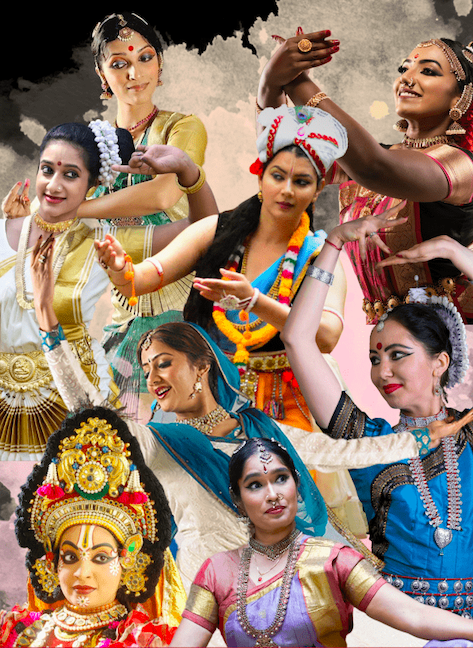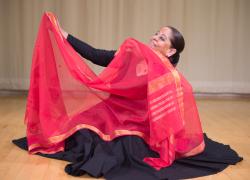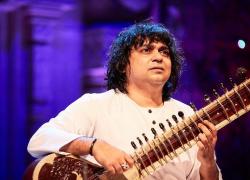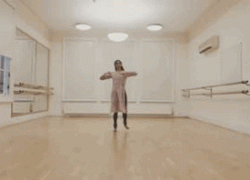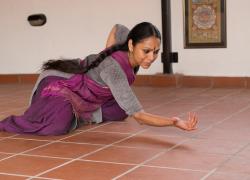Elemental Goddess
Elemental Goddess
Bhavan, London
2 October 2022
Reviewed by Annapoorna Kuppuswamy
On the 153rd birth anniversary of Mahatma Gandhi, a vociferous advocate of simple sustainable lifestyle, a conceptually novel classical Indian dance performance was presented as part of the Bhavan’s 50th anniversary celebrations. It built on ideas of sustainability and climate change both in the practice of the art, and the contents of classical repertoire. The concept was developed by Chamundeeswari Kuppuswamy and Mathangi Keshava, funded by Arts Council England and the Bhavan..
The performance showcased many of the classical dances of India including bharatanatyam, odissi, kuchipudi, manipuri and mohinyattam. In keeping with the theme, the costuming was kept simple with added style-specific highlights for each of the different classical dances. Each dancer introduced their piece in a pre-recorded video explaining why a particular piece was chosen and its link to the elements and climate change. Each of the elements were represented by goddesses which fortuitously was performed during Navarathri (9 nights), the Hindu festival lasting nine nights celebrating the divine feminine.
Mathangi Keshavan, bharatanatyam dancer and co-producer of the show, started off with a beautiful Muthuswami Deekshidar composition on Ganges. Portraying the decimation of water bodies in an interesting opening jathi (pure dance sequence) of the composition, the lyrics were a more traditional invocation to goddess Ganga. Despite the novel thematic elements, Mathangi was uncharacteristically nervous and lack-lustre in her presentation. Katrina Rute, an odissi dancer, presented the Jai Bhagavathi Stotram highlighting the element of fire. While I was eagerly anticipating the fluid elegance of odissi, I was rather underwhelmed by the performance. In contrast, Debanjali Biswas stormed onto the stage with a high-octane depiction of goddess Kali in all her fury portraying the destruction and upheaval of thunder, lightning and storms, very much the consequences of climate change. In the song from Sri Hari Sankirtan Sheireng Pareng, intermixing the vigorous tandava style of manipuri with martial arts moves that also featured vocalisation, Debanjali exuded effortless poise and strength in a flawless performance. Next up was kuchipudi. Amritha Jayakrishnan, who chose the goddess of snakes Manasa Devi, an unusual goddess, was a dynamite of energy, dancing to aadupaambe, a popular composition of Pambatti Siddhar (master of elements). Her unusual snake moves engaging every part of the body, interspersed with quintessential kuchipudi legwork was a delight to watch. Some of the links to the elements would have strengthened the thematic novelty of this choreography. After being hit by storms and snakes, calm was restored by the mohiniattam dancer, Ranjitha Chowalloor who performed a Devi Stuthi, in praise of the feminine divine presented in many forms, Lakshmi, Saraswathi and Durga. This beautiful piece set to a relatively sedate pace was delicately handled, sometimes too delicate, showcasing typical mohiniyattam moves. After a visual feast of classical dances, a guest performance by Devika Rao, doing yakshagana, was an absolute show-stopper. A clear distinction could be seen between the stylised classical arts and folk forms, expertly demonstrated by Devika bringing out the lighter interactive elements in the portrayal of Kama shooting different flower arrows at the Lord.
While the audience was left with a smile on their faces, having watched so many art forms in a single performance, the promised conceptual novelty didn’t quite deliver and even the costumes, though simple, looked very much like single-use apparel. The idea has great potential, but seemed a long way off from hitting the right notes and evoking the intended effect on audiences. After the performance, I caught up with Chamu, and asked her about her aspirations for the production. She said ‘Put together in just three months, Elemental Goddess is a proof of concept for us. It is possible for these different dancers to collaborate and get inspired by one concept – the earth systems, in which the elements play a key role. I hope this is the start of a disruptive innovation in classical dance in Britain.’

